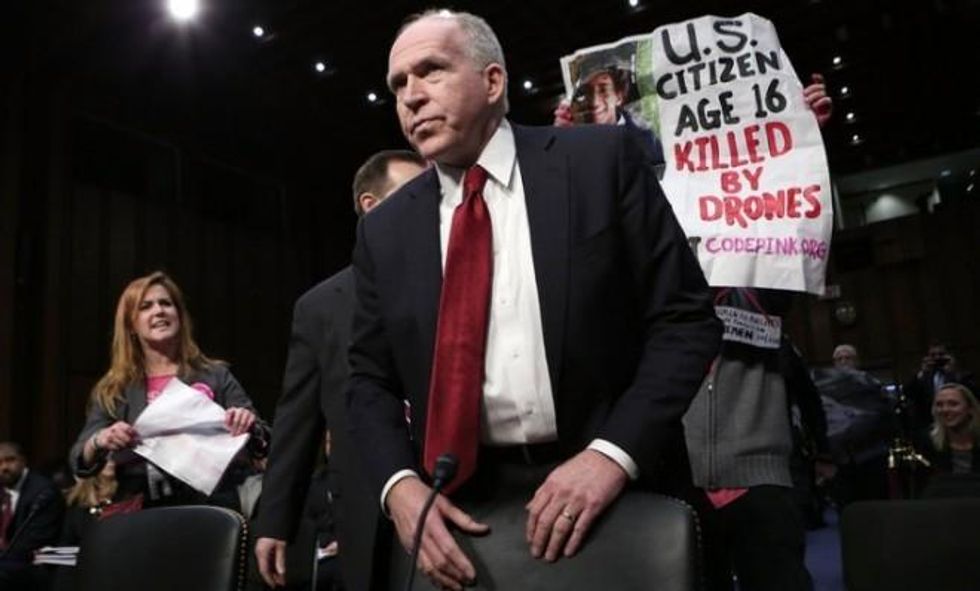Eric Holder, Northwestern Speech, March 5, 2012
First, the U.S. government has determined, after a thorough and careful review, that the individual poses an imminent threat of violent attack against the United States; second, capture is not feasible; and third, the operation would be conducted in a manner consistent with applicable law of war principles.
The evaluation of whether an individual presents an "imminent threat" incorporates considerations of the relevant window of opportunity to act, the possible harm that missing the window would cause to civilians, and the likelihood of heading off future disastrous attacks against the United States. As we learned on 9/11, al Qaeda has demonstrated the ability to strike with little or no notice - and to cause devastating casualties. Its leaders are continually planning attacks against the United States, and they do not behave like a traditional military - wearing uniforms, carrying arms openly, or massing forces in preparation for an attack. Given these facts, the Constitution does not require the President to delay action until some theoretical end-stage of planning - when the precise time, place, and manner of an attack become clear. Such a requirement would create an unacceptably high risk that our efforts would fail, and that Americans would be killed.
Whether the capture of a U.S. citizen terrorist is feasible is a fact-specific, and potentially time-sensitive, question. It may depend on, among other things, whether capture can be accomplished in the window of time available to prevent an attack and without undue risk to civilians or to U.S. personnel. Given the nature of how terrorists act and where they tend to hide, it may not always be feasible to capture a United States citizen terrorist who presents an imminent threat of violent attack. In that case, our government has the clear authority to defend the United States with lethal force.
Unknown Author, White Paper, November 8, 2011
First, the condition that an operational leader present an "imminent" threat of violent attack against the United States does not require the United States to have clear evidence that a specific attack on U.S. persons and interests will take place in the immediate future. Given the nature of, for example, the terrorist attacks on September 11, in which civilian airliners were hijacked to strike the World Trade Center and the Pentagon, this definition of imminence, which would require the United States to refrain from action until preparations for an attack are concluded, would not allow the United States sufficient time to defend itself. The defensive options available to the United States may be reduced or eliminated if al-Qa'ida operatives disappear and cannot be found when the time of their attack approaches. Consequently, with respect to al-Qa'ida leaders who are continually planning attacks, the United States is likely to have only a limited window of opportunity within which to defend Americans in a manner that has both a high likelihood of success and sufficiently reduces the probabilities of civilian casualties.
[snip]
By its nature, therefore, the threat posed by al-Qa'ida and its associated forces demands a broader concept of imminence in judging when a person continually planning terror attacks presents an imminent threat, making the use of force appropriate. In this context, imminence must incorporate considerations of the relevant window of opportunity, the possibility of reducing collateral damage to civilians, and the likelihood of heading off future disastrous attacks on Americans.
[snip]
With this understanding, a high-level official could conclude, for example, that an individual poses an "imminent threat" of violent attack against the United States where he is an operational leader of al-Qa'ida or an associated force and is personally and continually involved in planning terrorist attacks against the United States. Moreover, where the al-Qa'ida member in question has recently been involved in activities posing an imminent threat of violent attack against the United States, and there is no evidence suggesting that he has renounced or abandoned such activities, that member's involvement in al-Qa'ida's continuing terrorist campaign against the United States would support the conclusion that the members is an imminent threat. [my emphasis]
John Brennan, Harvard Law Speech, September 16, 2011
Others in the international community--including some of our closest allies and partners--take a different view of the geographic scope of the conflict, limiting it only to the "hot" battlefields. As such, they argue that, outside of these two active theatres, the United States can only act in self-defense against al-Qa'ida when they are planning, engaging in, or threatening an armed attack against U.S. interests if it amounts to an "imminent" threat.
In practice, the U.S. approach to targeting in the conflict with al-Qa'ida is far more aligned with our allies' approach than many assume. This Administration's counterterrorism efforts outside of Afghanistan and Iraq are focused on those individuals who are a threat to the United States, whose removal would cause a significant - even if only temporary - disruption of the plans and capabilities of al-Qa'ida and its associated forces. Practically speaking, then, the question turns principally on how you define "imminence."
We are finding increasing recognition in the international community that a more flexible understanding of "imminence" may be appropriate when dealing with terrorist groups, in part because threats posed by non-state actors do not present themselves in the ways that evidenced imminence in more traditional conflicts. After all, al-Qa'ida does not follow a traditional command structure, wear uniforms, carry its arms openly, or mass its troops at the borders of the nations it attacks. Nonetheless, it possesses the demonstrated capability to strike with little notice and cause significant civilian or military casualties. Over time, an increasing number of our international counterterrorism partners have begun to recognize that the traditional conception of what constitutes an "imminent" attack should be broadened in light of the modern-day capabilities, techniques, and technological innovations of terrorist organizations.


